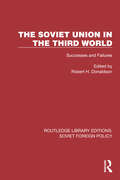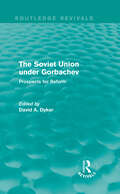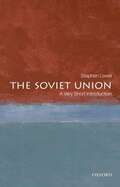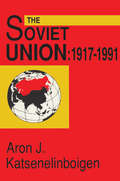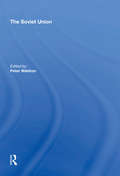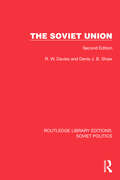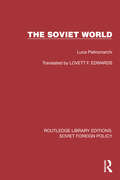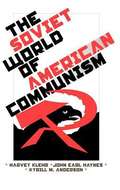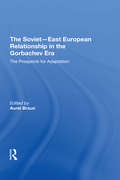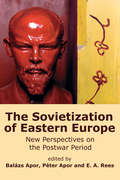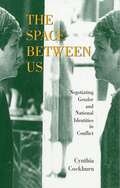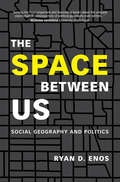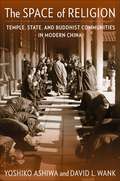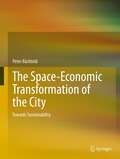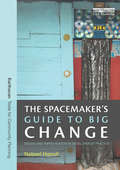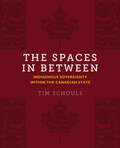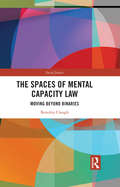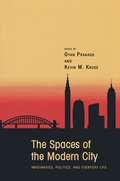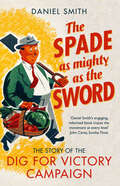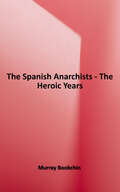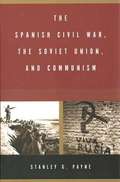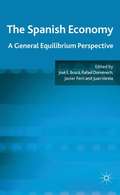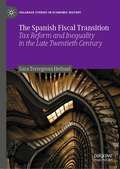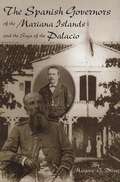- Table View
- List View
The Soviet Union in the Third World: Successes and Failures (Routledge Library Editions: Soviet Foreign Policy #20)
by Robert H. DonaldsonThe Soviet Union in the Third World (1981) analyses Soviet objectives in the developing world, the instruments of foreign policy employed and their success and failure, the implications of Soviet foreign policy for the international system in general and the US foreign and defence policies in particular. Twenty leading specialists examine Soviet involvement in Latin America, Africa, the Middle East and Asia, and discuss the subject from both security and economic perspectives.
The Soviet Union under Gorbachev: Prospects for Reform (Routledge Revivals)
by David A. DykerGorbachev’s accession to General Secretary promised great changes to the Soviet Union and its relationship with the rest of the world. This book, first published in 1987, discusses the problems faced by Gorbachev when he entered office and how he planned to tackle them. Gorbachev was a figure of genuine debate in the mid-1980s, raising doubts from Western specialists regarding his radicalism and ability to reform the Soviet economic system in particular. Here, Dyker and his colleagues assess the changes Gorbachev had already made to consolidate his power base, alongside those that he was proposing to make to agriculture, industry and foreign relations at the time of publication. The book speculates about how Gorbachev might implement his proposed political and economic reforms, what opposition he might encounter and how successful he would be. A fascinating insight into Soviet economic and political policy in the years leading up to the Union’s collapse, this work will be of particular importance to students and academics researching the personality of Gorbachev and the political and economic history of the Soviet Union.
The Soviet Union: A Very Short Introduction (Very Short Introductions Ser.)
by Stephen LovellThe Soviet Union at its height occupied one sixth of the world's land mass, encompassed fifteen republics, and stretched across eleven different time zones. More than twice the size of the United States, it was the great threat of the Cold War until it suddenly collapsed in 1991. Now, almost twenty years after the dissolution of this vast empire, what are we to make of its existence? Was it a heroic experiment, an unmitigated disaster, or a viable if flawed response to the modern world? Taking a fresh approach to the study of the Soviet Union, this Very Short Introduction blends political history with an investigation into Soviet society and culture from 1917 to 1991. Stephen Lovell examines aspects of patriotism, political violence, poverty, and ideology, and provides answers to some of the big questions about the Soviet experience. Throughout, the book takes a refreshing thematic approach to the history of the Soviet Union and it provides an up-to-date consideration of the Soviet Union's impact and what we have learnt since its end.
The Soviet Union: Empire, Nation, and System
by Aron KatsenelinboigenFirst Published in 2017. Routledge is an imprint of Taylor & Francis, an Informa company.
The Soviet Union: Essays For Olga Crisp (The\international Library Of Essays On Political History Ser.)
by Peter WaldronThe Soviet Union was one of the most significant historical phenomena of the twentieth century. This volume brings together key articles that analyse its birth in the 1917 revolution, the development of Stalin's tyranny and Soviet decline from the 1960s onwards. The collection includes scholarship of the highest quality that illuminates this key episode in the history of both Europe and the wider world.
The Soviet Union: Second Edition (Routledge Library Editions: Soviet Politics)
by R. W. DaviesThe Soviet Union (1989) examines the state of the Soviet Union at the end of the 1980s. The Soviet Union claimed to offer a new social, economic and political order – a planned socialist system – and this book looks at the Soviet alternative and the extent of its success. It surveys the major components of Soviet society and examines the principal issues and debates that surround its assessment.
The Soviet World (Routledge Library Editions: Soviet Foreign Policy #22)
by Luca PietromarchiThe Soviet World, first published in 1965, examines both the domestic society of the Soviet Union under Khrushchev and its foreign relations with the capitalist world. Khrushchev offered a challenge to the West, to compare the practical benefits to the people of communism and capitalism, and his foreign policies as much as his domestic policies aimed to prove the Soviet Union’s economic superiority to the United States.
The Soviet World of American Communism
by John Earl Haynes Harvey E. Klehr Kyrill M. AndersonBased on documents newly available from Russian archives, this book conclusively demonstrates the continuous and intimate ties between the Communist Party of the United States of America (CPUSA) and Moscow. The authors explains and annotate 95 documents, reproduced here in their entirety or in large part, and quote from others to reveal the actual workings of the American Communist Party.
The Soviet-East European Relationship In The Gorbachev Era: The Prospects For Adaptation
by Aurel BraunThis book focuses on the nature of the Soviet-East European relationship in the Gorbachev era and on the prospects for the adaptation of that relationship to changing conditions in today's world, examining trends and tendencies in Soviet-East European relations.
The Sovietization of Eastern Europe: New Perspectives on the Postwar Period
by Balzs AporThis essay anthology offers enlightening perspectives on how East-Central Europe was transformed into the “other” Europe during the Cold War era.When the Second World War ended, a new conflict arose between world powers jockeying for supremacy. The Soviet Union pursued a policy of exporting its system of government in a process known as sovietization. But there were also governments that sought to adopt a Soviet way of life on their own accord. Dictated by ideological imperatives, both styles of sovietization employed socialist strategies of state and nation building. This volume not only examines the imposition of new forms of government, but also the socialist response to modernity as reflected in approaches to new technology and management, consumption and leisure patterns, religious and educational policy, political rituals and attitudes to the past. The essays explore the diversity and the tensions within the sovietization process in the countries of the region. “This collection is a bold and timely attempt at shedding light on a rather insufficiently researched topic . . . the diverse approaches-ranging from socio-cultural and economic history to psycho-history.” —Dr. Dragos Petrescu, University of Bucharest.
The Space Between Us: Negotiating Gender and National Identities in Conflict
by Cynthia CockburnEven in places of deadly national enmity, some very ordinary people are routinely doing peace. In this highly original study, Cynthia Cockburn deepens our understanding of the processes sustaining conflict in Northern Ireland, Israel/Palestine and Bosnia/Hercegovina by means of a close involvement with three remarkable women's projects that have chosen co-operation. How, she asks, do they fill the dangerous space between them with words instead of bullets? How do they make democracy out of difference? <P><P>The book brings fresh insight to theories of the self in relation to collective identities, and of gender in nationalist thought and practice. Observing, in words and photographs, how these women's alliances create a safe space in which to work together, we learn more about the dangers of essentialism and the problematic relationship between identity and democracy.
The Space Between Us: Social Geography and Politics
by Ryan D. EnosThe Space between Us brings the connection between geography, psychology, and politics to life. By going into the neighborhoods of real cities, Enos shows how our perceptions of racial, ethnic, and religious groups are intuitively shaped by where these groups live and interact daily. Through the lens of numerous examples across the globe and drawing on a compelling combination of research techniques including field and laboratory experiments, big data analysis, and small-scale interactions, this timely book provides a new understanding of how geography shapes politics and how members of groups think about each other. Enos' analysis is punctuated with personal accounts from the field. His rigorous research unfolds in accessible writing that will appeal to specialists and non-specialists alike, illuminating the profound effects of social geography on how we relate to, think about, and politically interact across groups in the fabric of our daily lives.
The Space of Religion: Temple, State, and Buddhist Communities in Modern China (The Sheng Yen Series in Chinese Buddhist Studies)
by Yoshiko Ashiwa David L. WankThe Nanputuo Temple in the southeastern Chinese city of Xiamen has been a cherished site for the worship of the bodhisattva Guanyin for centuries. It was a center of modernizing Buddhism in the early twentieth century and a flagship for the revival of Buddhism after state suppression during the Cultural Revolution. The Space of Religion takes readers inside the Nanputuo Temple in order to explore the practice of Buddhism in modern China and the complex relationship between Buddhism and the Chinese state.Based on three decades of ethnographic research, Yoshiko Ashiwa and David L. Wank tell the story of Nanputuo against the backdrop of a dramatic stretch of Chinese history. They vividly depict episodes such as renovating the halls, reestablishing ties with overseas Chinese donors, conflicts with local government, revival of ritual life, reopening of its Buddhist academy, and the passion of the Guanyin birthday festival. To understand Nanputuo, Buddhist communities, and other temples in Xiamen, Ashiwa and Wank develop the concept of religion as a space constituted by physical, semiotic, and institutional dimensions. They also show how the Chinese state and Buddhism have each adapted to the other, as the temple has adjusted to government policy while the state has deployed Buddhism in its promotion of Chinese culture.This interdisciplinary book is both a theoretically generative analysis of religious spaces and an empirically rich account of the recovery of Buddhism in China after the Mao era.
The Space-Economic Transformation of the City
by Peter BächtoldCity planning is the key-stone to tackle the question of climate-change and to involve adequate action. In Part I of this book, the theory of space-economy is presented. Opening up a new conceptual and operational toolbox for policy makers, practitioners and scholars, the theory of space-economy is based on a rigorously structured thinking and acting in the field of sustainable urban planning and architecture. Europe has the greatest experience in sustainable city planning worldwide. In Part II, four of the most remarkable experiences (Vauban in Freiburg i.B., Kronsberg in Hannover, Western Harbour in Malmö, Hammarby Sjöstad in Stockholm) are presented, dissected conceptually and operationally a radically new way. The interest of the approach is not limited to European countries. In Part III is developed a project in Asia, in Ho Chi Minh City, faced with dramatic threats due to climate change and rapidly growing tidal and sea-level rise. Based on the experiences presented in Part II, the approach is integrated in this completely different context, thus becoming fully effective at a much bigger scale.
The Spacemaker's Guide to Big Change: Design and Improvisation in Development Practice (Earthscan Tools for Community Planning)
by Nabeel HamdiThis book gives definition to participatory practice as a necessary form of activism in development planning for cities. It gives guidance on how practice can make space for big and lasting change and for new opportunities to be discovered. It points to ways of building synergy and negotiating our way in the social and political spaces ‘in between’ conventional and often competing ideals – public and private interests, top down and bottom up, formal and informal, the global agendas which outsiders promote and the local needs of insiders, for example. It offers guidance on process, designed to close gaps and converge worlds which we know have become divisive and discriminatory, working from the detail of everyday life in search of beginnings that count, building out and making meaningful locally, the abstractions of the global causes we champion – poverty alleviation, environmental sustainability, resilience. Practice – the collective process by which decisions are negotiated, plans designed and actions taken in response to needs and aspirations, locally and globally – we will see, is not just about being practical, but more. Its purpose is to give structure to our understanding of the order and disorder in our cities today, then to disturb that order when it has become inefficient or inequitable, even change it. It is to add moral value to morally questionable planning practice and so build "a social economy for the satisfaction of human need." Practice in these spaces ‘in-between’ redraws the boundaries of expectation of disciplinary work and offers a new high ground of moral purpose from which to be more creative, more integrated, more relevant, more resourceful – more strategic.
The Spaces In Between: Indigenous Sovereignty within the Canadian State
by Tim SchoulsThe Spaces In Between examines prospects for the enhanced practice of Indigenous political sovereignty within the Canadian state. As Indigenous rights include the right to self-determination, the book contends that restored practices of Indigenous sovereignty constitute important steps forward in securing better relationships between Indigenous peoples and the Canadian state. While the Canadian state maintains its position of dominance with respect to the exercise of state sovereignty, Tim Schouls reveals how Indigenous nations are nevertheless carving out and reclaiming areas of significant political power as their own. By means of strategically acquired legal concessions, through hard-fought political negotiations, and sometimes through simple declarations of intent, Indigenous nations have repeatedly compelled the Canadian state to roll back its jurisdiction over them. In doing so, they have enhanced their prospects for political sovereignty within Canada. As such, they now increasingly occupy what Schouls refers to metaphorically as “the spaces in between.” The book asserts that occupation of these jurisdictional “spaces in between” not only goes some distance in meeting the requirements of Indigenous rights but also contributes to Indigenous community autonomy and well-being, enhancing prospects for reconciliation between Indigenous peoples and the Canadian state.
The Spaces of Mental Capacity Law: Moving Beyond Binaries (Social Justice)
by Beverley CloughThis book explores the conceptual spaces and socio-legal context which mental capacity laws inhabit. It will be seen that these norms are created and reproduced through the binaries that pervade mental capacity laws in liberal legal jurisdictions- such as capacity/incapacity; autonomy/paternalism; empowerment/protection; carer/cared-for; disabled/non-disabled; public/private. Whilst on one level the book demonstrates the pervasive reach of laws questioning individuals mental capacity, within and beyond the medical context which it is most commonly associated with, at a deeper and perhaps more important level it challenges the underlying norms and assumptions underpinning the very idea of mental capacity, and reflects outwards on the transformative potential of these realisations for other areas of law. In doing so, whilst the book offers lessons for mental capacity law scholarship in terms of reform efforts at both domestic and internationals levels, it also offers ways to develop our understandings of a range of linked legal, policy and theoretical concepts. In so doing, it offers new critical vantage points for both legal critique and conceptual change beyond mental capacity law. The book will be of interest to researchers in mental capacity law, disability law and socio-legal studies as well as critical geographers and disability studies scholars.
The Spaces of the Modern City: Imaginaries, Politics, and Everyday Life (Publications in Partnership with the Shelby Cullom Davis Center at Princeton University #2)
by Gyan Prakash & Kevin M. KruseBy United Nations estimates, 60 percent of the world's population will be urban by 2030. With the increasing speed of urbanization, especially in the developing world, scholars are now rethinking standard concepts and histories of modern cities. The Spaces of the Modern City historicizes the contemporary discussion of urbanism, highlighting the local and global breadth of the city landscape. This interdisciplinary collection examines how the city develops in the interactions of space and imagination. The essays focus on issues such as street design in Vienna, the motion picture industry in Los Angeles, architecture in Marseilles and Algiers, and the kaleidoscopic paradox of post-apartheid Johannesburg. They explore the nature of spatial politics, examining the disparate worlds of eighteenth-century Baghdad, nineteenth-century Morelia, Cold War-era West Berlin, and postwar Los Angeles. They also show the meaning of everyday spaces to urban life, illuminating issues such as crime in metropolitan London, youth culture in Dakar, "memory projects" in Tokyo, and Bombay cinema. Informed by a range of theoretical writings, this collection offers a fresh and truly global perspective on the nature of the modern city. The contributors are Sheila Crane, Belinda Davis, Mamadou Diouf, Philip J. Ethington, David Frisby, Christina M. Jiménez, Dina Rizk Khoury, Ranjani Mazumdar, Frank Mort, Martin Murray, Jordan Sand, and Sarah Schrank.
The Spade as Mighty as the Sword: The Story of the Dig for Victory Campaign
by Daniel SmithThe little-known history of the “Garden Front”—Britain’s wildly successful vegetable-growing campaign during WWII: “A fascinating story.” —Northern EchoAfter food rationing was introduced in 1940, and German U-boats began threatening merchant shipping bringing in essential foodstuffs, the Ministry of Agriculture decided something had to be done to make the kitchens of Britain more self-sufficient.The result was an amazingly effective campaign—Dig for Victory—encouraging every man and woman to turn their garden, or even the grass verge in their street, over to cultivating vegetables. By 1942 half the population were taking part, and even the Royal Family had sacrificed their rose beds for growing onions.Now, Daniel Smith tells the full story of this remarkable wartime episode when spades, forks, and bean canes became weapons the ordinary citizen could take up against the enemy. It had tangible benefits for the war effort in that shipping could be reallocated for munitions instead of food imports, as well as for the health of the nation in encouraging a diet of fresh fruit and veg. The campaign also created unexpected celebrities like C.H. Middleton, whose wartime BBC radio talks on gardening reached a vast audience, and even sowed the seeds for the modern allotment movement.Ultimately it is a war story without fighting or killing, one that shows how even The Little Man with the Spade, in the words of the Minister for Agriculture at the time, did his bit for Victory.“Engaging.” —The Sunday Times“An inspirational account.” —Lancashire Evening Post
The Spanish Anarchists: The Heroic Years 1868-1936
by Murray Bookchin"The seminal history of Spanish anarchism: from its earliest inception to the organizations that claimed over two million members on the eve of the 1936 Revolution. Hailed as a masterpiece, it includes a new prefatory essay by the author. "I've read The Spanish Anarchists with the excitement of learning something new. It's solidly researched, lucidly written, and admirably fair-minded... Murray Bookchin is that rare bird today, a historian." —Dwight MacDonald "I have learned a great deal from this book. It is a rich and fascinating account... Most importantly, it has a wonderful spirit of revolutionary optimism that connects the Spanish anarchists with our own time." —Howard Zinn Murray Bookchin has written widely on politics, history, and ecology. His books To Remember Spain: The Anarchist and Syndicalist Revolution of 1936, The Ecology of Freedom, Post-Scarcity-Anarchism, The Ecology of Freedom, and Social Anarchism or Lifestyle Anarchism: An Unbridgeable Chasm—are all published by AK Press.
The Spanish Atlantic World in the Eighteenth Century
by Allan J. Kuethe Kenneth J. AndrienThis volume elucidates Bourbon colonial policy with emphasis on Madrid's efforts to reform and modernize its American holdings. Set in an Atlantic world context, the book highlights the interplay between Spain and America as the Spanish empire struggled for survival amid the fierce international competition that dominated the eighteenth century. The authors use extensive research in the repositories of Spain and America, as well as innovative consultation of the French Foreign Affairs archive, to bring into focus the poorly understood reformist efforts of the early Bourbons, which laid the foundation for the better-known agenda of Charles III. As the book unfolds, the narrative puts flesh on the men and women who, for better or worse, influenced colonial governance. It is the story of power, ambition and idealism at the highest levels.
The Spanish Civil War, the Soviet Union, and Communism
by Stanley G. PayneIn this compelling book Stanley G. Payne offers the first comprehensive narrative of Soviet and Communist intervention in the revolution and civil war in Spain. He documents in unprecedented detail Soviet strategies, Comintern activities, and the role of the Communist party in Spain from the early 1930s to the end of the civil war in 1939. Drawing on a very broad range of Soviet and Spanish primary sources, including many only recently available, Payne changes our understanding of Soviet and Communist intentions in Spain, of Stalin's decision to intervene in the Spanish war, of the widely accepted characterization of the conflict as the struggle of fascism against democracy, and of the claim that Spain's war constituted the opening round of World War II. The author arrives at a new view of the Spanish Civil War and concludes not only that the Democratic Republic had many undemocratic components but also that the position of the Communist party was by no means counterrevolutionary
The Spanish Economy
by José E. Boscá Rafael Doménech Javier Ferri Juan VarelaThis book examines the pattern of growth of the Spanish economy in the last few decades, and studies the causes of its labour productivity, and the special features characterising business cycles in Spain.
The Spanish Fiscal Transition: Tax Reform and Inequality in the Late Twentieth Century (Palgrave Studies in Economic History)
by Sara Torregrosa HetlandThis book provides an analysis of the process and outcomes of the tax reform, with a focus on progressivity, redistribution, and inequality. Between 1977 and 1986, Spain underwent a comprehensive tax reform which shaped its fiscal system until today. It was made in connection with the transition to democracy and indeed was understood as a fundamental part of the political change. The book situates the reform both within Spanish history and international trends in tax systems and connects it to the expansion of the welfare state and regional decentralization in Spain. The analysis reveals that the tax system failed to attain progressivity, and significant levels of fraud had a noticeable impact on inequality. Because of this, fiscal redistribution remained limited. In the new political economy of the second globalization, late democratic and fiscal transitioners were unable to emulate the path of the welfare state forerunners.
The Spanish Governors Of The Mariana Islands And The Saga Of The Palacio
by Marjorie G. DriverMore than fifty Spanish officers served as governors during the 230 years that Spain administered the Mariana Islands, from 1668 to 1898. A dozen or so received six-year royal appointments, made in Madrid by the king, though the vast majority served three-year interim appointments, made in Manila by the Governor General or the Audiencia. In the nineteenth century, as the newly designated Province of the Mariana Islands, appointments to the governorship were often made by the Captaincy General of the Philippines. The source materials for this work are found primarily among the holdings of the Micronesian Area Research Center, Spanish Documents Collection, a secondary repository with copies of documentary materials concerning Micronesia from institutional collections in various parts of the world, though primarily Spain, Mexico, and the Philippines.
